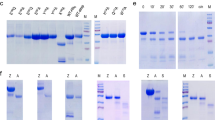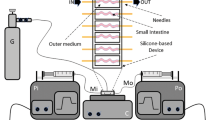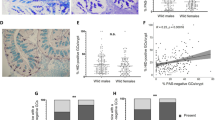Abstract
Summary: The uptake of 0.5 mM glycyl-L-proline (Gly-Pro), a substrate which has affinity for the dipeptide specific carrier system and is not hydrolyzed in the brush border, was studied in vitro in jejunum and ileum of rabbits from the 25th day of gestational age into adulthood. For comparison, uptake of 0.5 mM glycine was studied too. Results show that influx of Gly-Pro is present from the earliest age studied and show a steep prenatal increase and peaks at birth, with values, in the newborn jejunum, of 45.2 ± 3.3 μmoles/ghr (mean ± S.E.). Thereafter, the uptake slowly declines toward the adult level of 3.8 ± 0.5 μmoles/ghr. A similar pattern was present in the ileum. On the contrary, free glycine uptake shows no statistically significant change during the whole period studied.
The characteristics of the Gly-Pro influx process have been studied in the period of its peak activity (1-to 6-day-old rabbits) in both jejunum and ileum. The process is not inhibited by a 40-fold excess of glycine, proline, phenylalanine, leucine, lysine, glutamic acid, while it is strongly inhibited by a 10-fold excess of the dipeptides leucyl-leucine, alanyl-proline, glycyl-leucine and lysylleucine. A large excess of Gly-Pro has no inhibitory effect on the uptake of free glycine. The kinetic constants for Gly-Pro uptake are: Vmax = 126.7 ± 26.4 μmoles/ghr and Kt = 0.98 ± 0.26 mM in the jejunum and Vmax = 59.6 ± 9.2 and Kt = 0.70 ± 0.10 in the ileum. The removal of Na from the incubation and preincubation medium approximately halves the Vmax in both segments, leaving unchanged the affinity constants.
These results indicate that a very efficient dipeptide influx process occurs in the newborn rabbit. This process displays many characteristics in common with that described in the adult: it is not shared by amino acids free in the lumen; has a broad specificity for dipeptides and shows the same pattern of Na dependence. However, its maximal velocity is in the newborn much higher than in the adult.
Therefore, (1) the developmental patterns of the transport systems for Gly-Pro and for free glycine are different; this provides ontogenetic evidence for the distinction between dipeptide and free amino acid carrier systems; and (2) dipeptide uptake plays a predominant role in the physiology of the protein absorptive-digestive processes of the youngster.
Speculation: Dipeptide uptake is likely to play a major role in the final stages of protein absorption in the youngster. Thus, wherever proteic oral supplementation is indicated in the newborn or young infant, the administration of free amino acids does not appear to be physiologically appropriate.
Similar content being viewed by others
Log in or create a free account to read this content
Gain free access to this article, as well as selected content from this journal and more on nature.com
or
Author information
Authors and Affiliations
Rights and permissions
About this article
Cite this article
Guandalini, S., Rubino, A. Development of Dipeptide Transport in the Intestinal Mucosa of Rabbits. Pediatr Res 16, 99–103 (1982). https://doi.org/10.1203/00006450-198202000-00004
Issue date:
DOI: https://doi.org/10.1203/00006450-198202000-00004
This article is cited by
-
Di- and tripeptide transport in vertebrates: the contribution of teleost fish models
Journal of Comparative Physiology B (2017)
-
Molecular cloning, distribution and ontogenetic expression of the oligopeptide transporter PepT1 mRNA in Tibetan suckling piglets
Amino Acids (2009)



